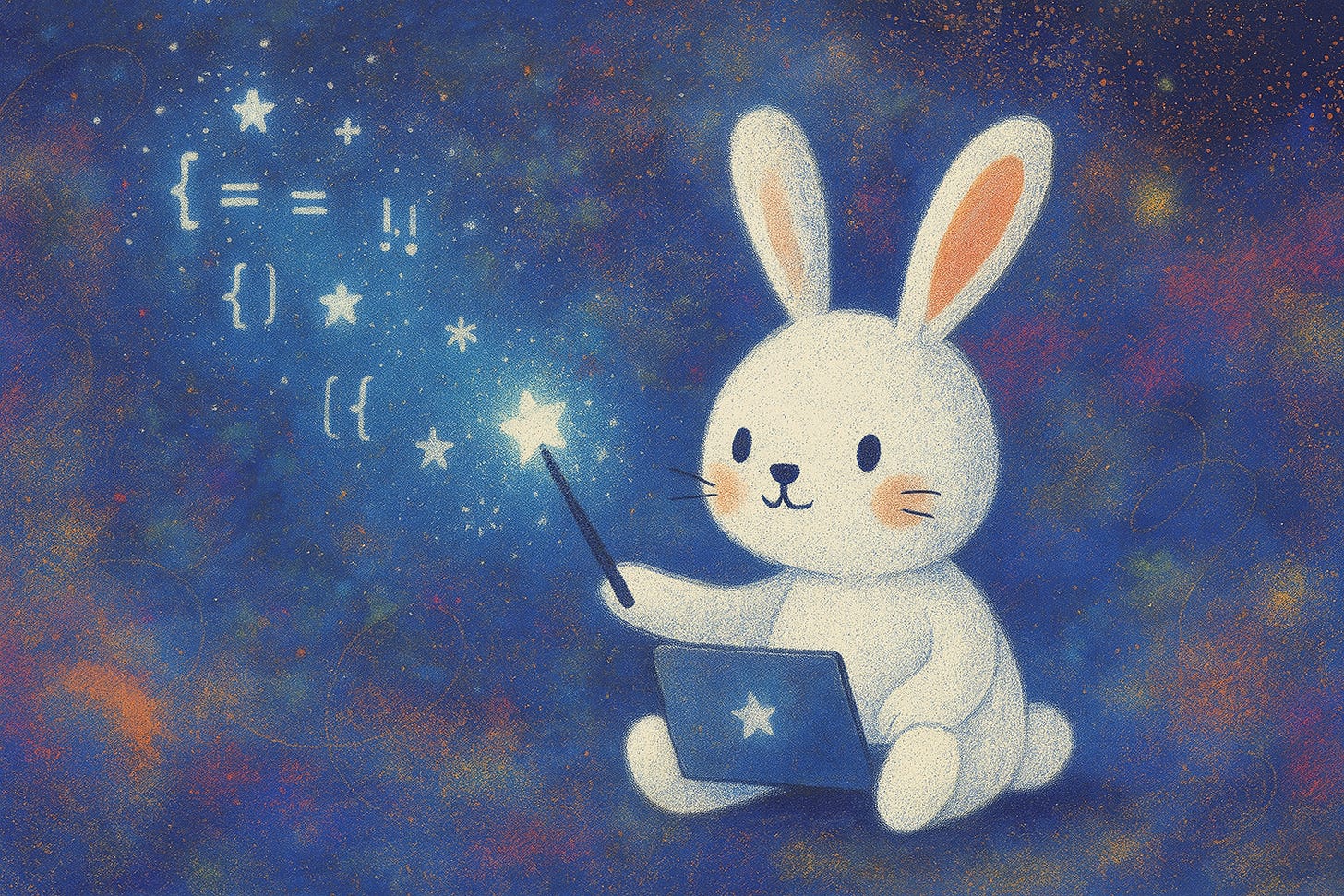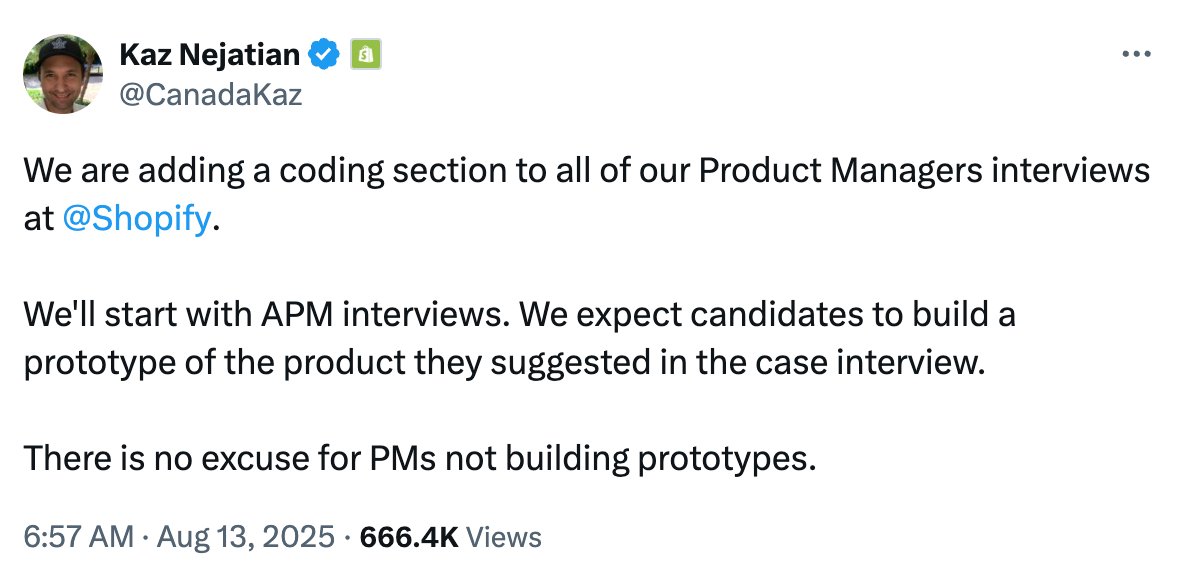Vibe coding is the new way to stand out in tech job applications
Vibe coding is moving faster than any other AI trend. Here’s a complete guide to build your 1st vibe coding project in 1 hour.
💎 Welcome to futureproof, a newsletter about building a career that thrives no matter how quickly the world changes.
If you’re not a subscriber yet, here’s what you missed:
Read time: 6 minutes
Vibe coding is one of the fastest-moving trends in tech careers. And unlike other AI skills, it’s already being formally assessed in interviews.
Of all the AI skills people talk about (prompt engineering, fine-tuning, eval writing), vibe coding is the only one companies are making public statements about adding to their product management hiring process:
Resumes → replaced by demos
LinkedIn’s new Associate Product Builder program doesn’t want your resume. The first step of the application is a 60-second demo of something you built.Interviews → upgraded with live vibe coding
Shopify’s COO announced they’re adding a (vibe) coding section to every PM interview.
So if you’re overwhelmed by which AI skills to learn, start here! Vibe coding is one of the most practical skills you can pick up right now.
In this post, I’ll walk you through how to:
Brainstorm project ideas that solve a real problem and showcase your product sense
Pick a beginner-friendly prototyping tool
Build the 1st version of your project
Refine your project with natural language
Showcase your project on a resume
Demo your project at events and career fairs
Get real users
Talk about your project during interviews
Step 1: How to come up with project ideas that solve a real problem and showcase your product sense
The best projects solve a real problem you’re motivated to solve. To identify a problem worth solving, ask yourself:
Moments of friction
When do you find yourself saying "there has to be a better way to do this"?
What's the most annoying task you do multiple times per week?
What process feels like it has too many unnecessary steps?
What app do you use that makes you think "I wish this had..."?
What's something you procrastinate on because the existing tools are too clunky?
Where do you find yourself regularly using workarounds or hacks?
Workflow gaps
What information do you wish was automatically connected but isn't?
What do you find yourself copying/pasting between different apps?
What reminder or notification do you wish existed but doesn't?
Micro-interactions & delight
What's a boring task that could be surprisingly fun with the right interface?
How could you make something tedious feel like a game?
What's an everyday interaction that could feel more magical?
Here are the projects I’ve created with vibe coding tools:
Social: Collaborative bingo card for your friend group’s bucket list
Productivity: Describe your dream life, and get daily reminders and affirmations delivered to your inbox (uses OpenAI API and Gmail API)
Sports: Digitize, animate, and visualize sports plays from any angle on the court. Works for basketball, football, and more.
Healthcare/education: Chatbot that helps healthcare trainees/medical students practice having difficult conversations with patients.
Design: Drag-and-drop ikebana composer, inspired by @meshtimes!
Step 2: Pick a prototyping tool
Beginner-friendly tools include:
v0 (Get started for free: v0.dev)
Emergent (Get started for free: emergent.sh)
Lovable (Get started for free: lovable.dev)
Bolt (Get started for free: bolt.new)
HeyBoss (Get started for free: heyboss.ai)
Step 3: Drop your idea in the prototyping tool
Example, paste this:
Build a drag-and-drop flower arrangement app. On the left, show me options for vases, flowers, and leaves. On the right, build a canvas where I can add elements and resize, rotate, crop, and arrange them in layers.
You can also upload screenshots of products you like as inspiration.
Step 4: Continue refining your project by describing the changes you want to see
And if the project has errors, screenshot them and ask the tool to help you fix it.
Step 5: How to write about your project on your resume
If you don’t have impact metrics and usage data: Built [project name], which helps [user] do [task] so they can [outcome]. Used [prototyping tool].
If you do have impact metrics and usage data, include those!
Step 6: How to talk about your project at an event
A shortcut I used to land interviews was showing up to events with a project I could demo on my phone. Here’s how you can do the same thing at job fairs, networking events, hackathons, conferences, and more.
During the event:
Prepare a 2-3 sentence explanation about what problem your project solves, and how.
Example: “I’m Sophia, and I built a tool that helps students keep up with their social life. Most events we hear about are through Instagram posts or physical flyers, but it’s annoying to manually add them to your calendar. With my tool, you just snap a photo or screenshot, and it automatically creates a Google calendar event for you.”
After the event:
Send an email like this:
“Hi [name], it was great meeting you at [event]. I’m Sophia — we chatted about my project [describe your project]. I’ve already applied for the [internship name and look forward to hearing back from your team. My resume is attached — looking forward to hearing from your team.”
Step 7: How to get real users for your product
Make a quick 30-second demo video, then share it on social media (e.g., TikTok, Instagram, relevant Facebook groups and subreddits).
Step 8: How to talk about your project during your interview
Interviewers will assess your product sense. Similar to the framework you use to solve a product sense interview question, be prepared to talk about:
What problems/pain points are you solving? How did you prioritize which problem to solve?
What solutions did you consider? How did you pick the solution?
Are there existing solutions for this problem? How is your project different from existing solutions?
How did you get people to use the product? What was their feedback? How did prioritize the feedback you were getting? How did you adapt to their feedback?
What were some challenges you encountered while building this? How did you overcome those challenges?
If you had more time, what additional features would you add?
How do you define success for your product?




Do you have any tips on how to add these projects on your resume and what it should look like?